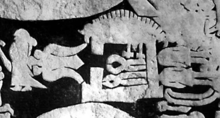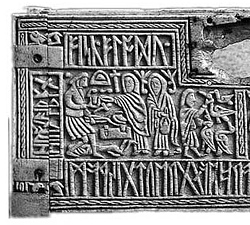Wayland the Smith
"crafting one"[2]) is a master blacksmith originating in Germanic heroic legend, described by Jessie Weston as "the weird and malicious craftsman, Weyland".A number of other visual and textual sources clearly allude to similar stories, most prominently the Old English poem Deor and the Franks Casket.[5] The oldest reference known to Wayland the Smith is possibly a gold solidus with a Frisian runic inscription ᚹᛖᛚᚪᛞᚢ wela[n]du 'wayland'.[10][9] A number of other possible visual representations exist in early medieval Scandinavia, but are harder to verify as they do not contain enough distinctive features corresponding to the story of Wayland found in textual sources.In revenge, Völundr killed the king's sons when they visited him in secret, and fashioned goblets from their skulls, jewels from their eyes, and a brooch from their teeth.The events described at King Niðung's court (identifiable with Niðhad in the Eddic lay) broadly follow the version in the Poetic Edda (though in the saga his brother, Egil the archer, is present to help him to make his wings and to help Velent escape[16]).Wayland here also wears a blood-filled bladder as a prop, instructing Egil to aim his arrow at this bag, thus feigning injury and deceiving the king.In the front panel of the Franks Casket, incongruously paired with an Adoration of the Magi, Wayland stands at the extreme left in the forge where he is held as a slave by King Niðhad, who has had his hamstrings cut to hobble him.[4] The Old English poem Deor, which recounts the famous sufferings of various figures before turning to those of Deor, its author, begins with "Welund": Weland had fashioned the mail shirt worn by Beowulf according to lines 450–455 of the epic poem of the same name: The reference in Waldere is similar to that in Beowulf – the hero's sword was made by Weland[31] – while Alfred the Great in his translation of Boethius asks plaintively: "What now are the bones of Wayland, the goldsmith preeminently wise?"[32]: p.[3] Wayland is known by the name Wieland in line 965 of the Latin epic Waltharius, a literary composition based on Old High German oral tradition, as the smith who made the poem's eponymous protagonist's armor:This belief is mentioned in the first episode of Puck of Pook's Hill by Rudyard Kipling, "Weland's Sword", which narrates the rise and fall of the god.[32]: p.[citation needed] In the ITV Series Robin of Sherwood, Wayland the Smith was credited for creating the Seven Swords that were charged with "the Power of Light and Darkness".






List of Fables charactersPoetic EddaGermanic mythologyOld EnglishOld NorseOld FrisianGermanOld High GermanOld FrenchProto-GermanicGermanic heroic legendJessie WestonVölundarkviðaÞiðreks sagaFranks CasketWaldereBeowulfGerman poems about Theoderic the GreatWitigeCharlemagnepaladinsCurtanaDurendalJoyeuseElder FutharkSchweindorfEast FrisiasolidusOstfrieslandfjaðrhamrArdre image stone VIIISlagfiðrValkyriesÖlrúnHervör alvitrHlaðguðr svanhvítswan maidenNiðhadNerikehamstrungBöðvildrgobletsbroochVelents þáttr smiðsNiðungMimungWidekeLabyrinthDaedalusÞorsteins saga Víkingssonarmagic swordmagic ringBritish MuseumAdoration of the MagihamstringsViking Agenorthern EnglandHalton, LancashireWest YorkshireSherburn-in-ElmetBedaleNorth YorkshireWayland's SmithyUffington White Horsesixpenny pieceLeeds CrossLeeds MinsterNithadBeadohildemail shirtepic poemsame nameHrethelHygelacHeaneyAlfred the GreatBoethiusromanceRhydderch HaelMerlinChild HornWalthariusburial moundBerkshire DownsmegalithicPuck of Pook's HillRudyard KiplingSir Walter ScottKenilworthcomposerSiegmund von HauseggerLeopold van der PalsRobin of SherwoodHerne the HunterCulture of NärkeFlibbertigibbetGobannusGoibniuIlmarinenKurdalægonSigurdTlepshWieland der SchmiedVulcan (mythology)Wieland der Schmied (Hitler)public domainChisholm, HughEncyclopædia BritannicaRygh, OlufHarris, JosephClover, Carol J.Lindow, JohnHenderson, GeorgeGordon, R. K.Unger, HenrikAnglo-Saxon paganismĒostreGefjonHrethaSaxnotÞunorWōdenEormenricHengist and HorsaSceafaCofgod